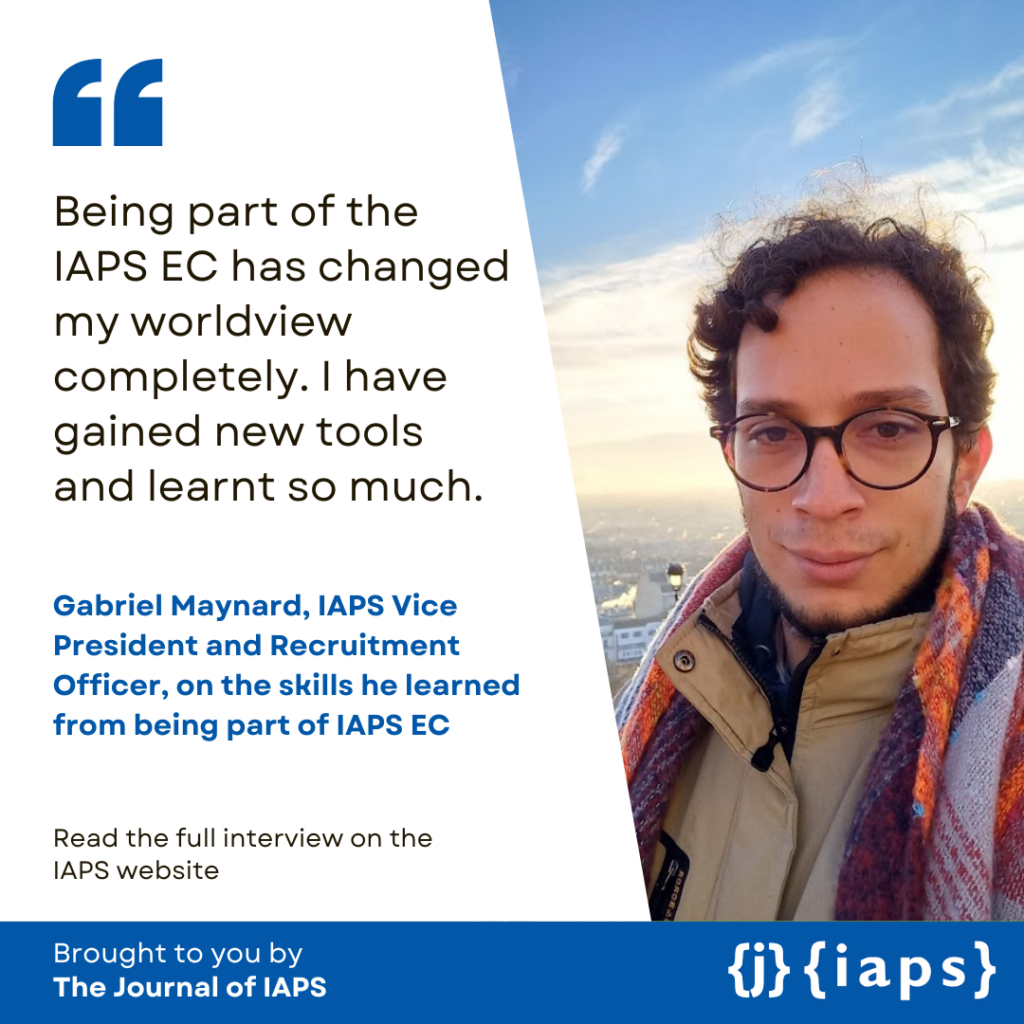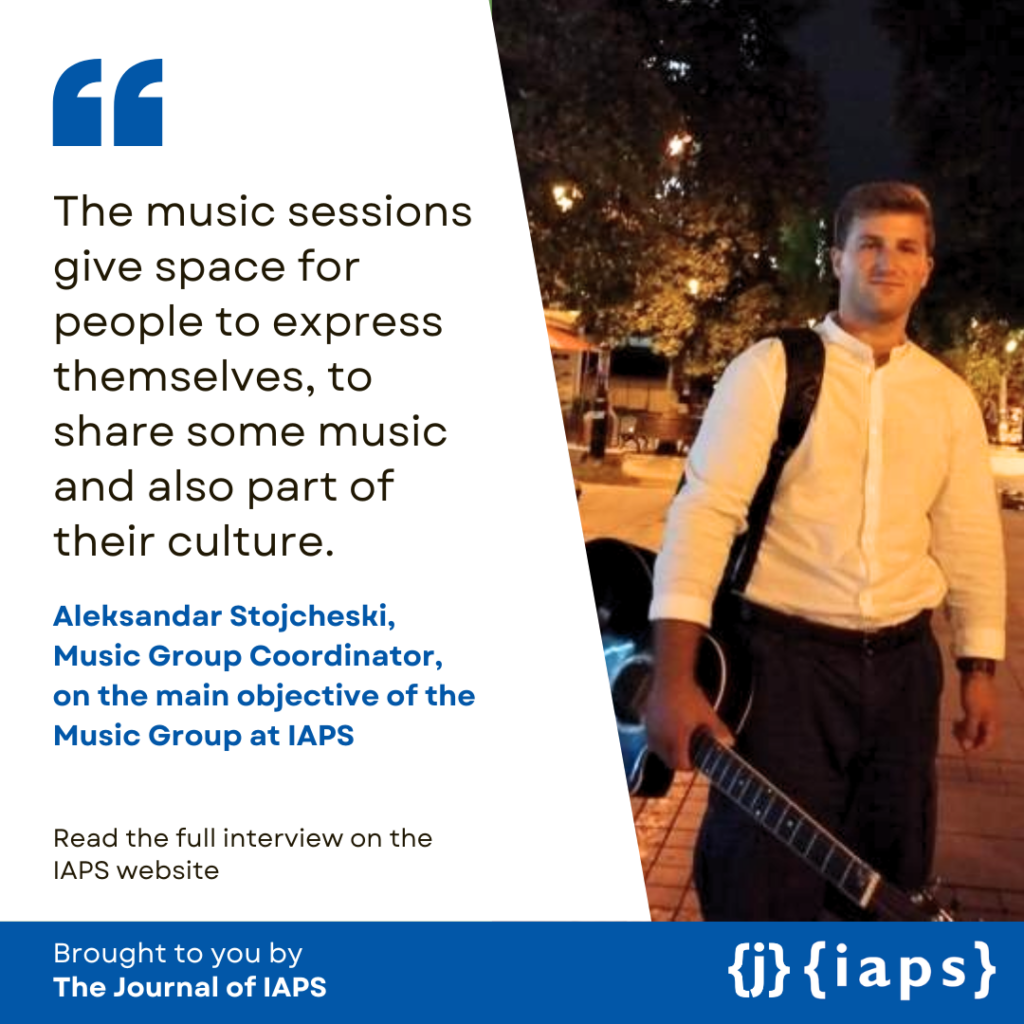Author: 🇵🇭 Harvey Sapigao
In celebration of World Quantum Day 2023, the jIAPS Article of the Month is quantum-themed.
———-
“Oh, so you study physics. What are you going to be? A physician?”
We often get this comment after telling people our degree. The confusion is understandable; ‘physician’ and ‘physicist’ do sound alike, have similar etymologies (both coming from the Latin word ‘physica’), and might as well mean one or the other in a parallel universe. But I once got a remark that I was going to be a psychologist, which I thought was a bit of a stretch.
We often think concepts in physics are so far removed from psychology, other than the fact that working with the Schrodinger equation can make our brains hurt. But physics, especially in the realm of quantum mechanics, is actually helping explain things about our minds, and these insights might also help us with our own mental well-being.
The obvious connection between quantum mechanics and psychology is that our brains are composed of matter, and matter, on the subatomic level, behaves quantum mechanically. Neurons typically communicate by passing ions to one another (1). The channels through which these ions pass are only fractions of nanometers thick – small enough for quantum effects to occur (2). In fact, the transmission of ions has shown to be compatible with quantum tunneling models (3). This is a stark departure from the classical notion that ions simply pass through channels like balls through tubes.
But the contribution of quantum mechanics goes far beyond neurons and ions. We now know that elementary particles don’t just strictly behave as particles; they also behave as waves. And just as there is a wave-particle duality in quantum mechanics, there is an analogous paradox in psychology: the mind-brain duality (also known as the mind-body duality, or ‘bodymind’) (4).
When classical physics was the only version of reality we knew, the idea of the mind and the brain was that of a dualism, not duality (5). That is, the mind and the brain were thought to be two completely different things. The thoughts, feelings, experiences, and everything that cannot be represented by matter were separated from those that can. ‘Mental’ states were separated from ‘physical’ states much like how waves were separated from particles.
René Descartes popularized this dualism and was named after him (5). Cartesian dualism is a seemingly innocuous – even helpful – dichotomy, but it has actually contributed to the mental health stigma we are facing to this day (6,7). This dualism has contributed to the notion that mental problems are very different from physical ones, and so, in many countries still, psychiatric hospitals are separated from general hospitals (7). Throughout history, treatments for the mentally ill have often been very different from those for the physically ill, and even the phrase ‘mentally ill’ has a negative connotation (7,8). Cartesian dualism has also contributed to the common misconception that mental issues are “all in the mind” and can be treated with having the right mindset (6).
Quantum mechanics brought the idea that reality wasn’t as cut and dry as we thought it was. Atoms can be in a superposition of states: a wave and a particle. And so, duality was born. This helped us understand that mental health might be both a mental and a physical affair; a duality – not dualism – of the mind and the brain.
Needless to say, mental health is not the same as physical health. But the two are not so dissimilar that treatments for the former were once thought of as witchcraft and the latter as medical science, as was the case in the time of Descartes (9). Indeed, research suggests that psychiatric drugs are just as effective in treating mental illnesses as other medical drugs are in treating physical illnesses (10). However, since mental health is also dependent on the mind, other treatments such as cognitive-behavioral therapy (CBT), or talk therapy, also work (11). Psychiatric drugs address the problem in a physical sense while talk therapy addresses it in a mental sense, and yet one can be as effective as the other.
***
We know that the physical aspect (the brain) is made of matter (quite literally, the gray and white matter), but what exactly is the mental aspect (the mind)?
Elementary particles – electrons, photons, quarks, etc. – are the smallest units of matter, and in quantum mechanics they come in discrete units called quanta. In psychology, a similar concept arises: the qualia (12). Qualia describes a unit of subjective experience; it is the color yellow as perceived by our eyes; the note A-flat as perceived by our ears; the feeling of tingles as perceived by our skin. That’s qualia. And whether or not we like the look of yellow, or the sound of A-flat, or the sensation of tingles, is also qualia. Put together, these hints of experiences make up our consciousness, and our consciousness, in essence, is what we have been calling the mind. Indeed, qualia make up the mind just as quanta (elementary particles) make up the brain, and that the mind-brain is the quality and quantity of a human.
An important feature of consciousness is that it is personal. It is based on our own subjective experiences; we all see colors, hear notes, feel sensations, differently. Moreover, we experience things in only one way: our own. Therefore, equating one’s own experiences to those of another is not only futile, but also impossible.
But some argue that consciousness is merely the result of matter interacting with one another; they are simply the result of neurons and ions playing around. There are, of course, conscious processes that can be mapped out in the brain; for example, the prefrontal cortex – the part of the brain near the forehead – activates whenever we act in a conscious manner, such as speaking, as opposed to, say, snoring while sleeping (13,14). But how consciousness emerges from the ‘lighting up’ of those neurons is still a mystery.
Consider a classic example in philosophy: the ‘chairness’ of a chair. Different materials, such as wood, metal, and plastic, can be used to make a chair. When these materials meet our rudimentary standard of what a chair is — something that can be sat on, have legs, and stand on its own — they become a chair. These properties emerge as special characteristics of a chair, but are not intrinsic to the wood, metal, or plastic from which the chair is made. Only when these materials are arranged in a particular way do they acquire these properties; wood, for example, cannot be sat on, have legs, and stand on its own unless it is assembled as a chair. These properties — the chairness of a chair — seem to appear out of nowhere, beyond the physicality of the materials.
Consciousness seems to appear out of nowhere, too. These networks of neurons are intertwined in a way that makes consciousness emerge. Consciousness is not a property of a bunch of neurons, just as chairness is not a property of a bunch of wood. But arrange them like a live brain, and consciousness emerges.
The idea that we are nothing more than the result of interactions of matter is called ‘materialism’ (15). Materialists think that consciousness is an illusion, as is the chairness of a chair. This view was especially popular before quantum mechanics, when all we knew about the world was in terms of balls revolving around bigger balls (whether that be electrons revolving around the nucleus or planets revolving around the sun).
Now, some find materialism difficult to accept. As we now know, funky stuff happens in the quantum realm, and most, if not all, cannot be expressed in terms of definite, intact balls. If the materialists are right, what would then be the difference between an alive and a dead person, if all there is to them are essentially balls? How did a bunch of mindless, zombie atoms conspire to create a brain-full, alive-and-kicking human being? Philosopher William Luijpen mentioned a contradiction among materialists: they philosophize and classify themselves as the same with chairs and tables, yet philosophizing and classifying are actions chairs and tables cannot do (16).
Still, what consciousness really is (and if it even exists) remains contentious in the fields of psychology, philosophy, and more recently, artificial intelligence. But one of the most commonly accepted views today is that consciousness coexists with matter, and we cannot be human without having one or the other. If we lose consciousness forever, we become corpses (a.k.a dead), and if we lose matter forever, we become, in paranormal terms, a ‘soul’* (a.k.a dead).
***
One of the interpretations of quantum mechanics, the von Neumann-Wigner Interpretation, assumes that consciousness exists. John von Neumann and Eugene Wigner’s interpretation was inspired by the earlier Copenhagen Interpretation.
Naturally, in a quantum mechanics sense, the wave/particle’s state is a cloud of probability; the state is indefinite, having no exact value. Its state can only be described in a probabilistic curve based on its wave function. But upon measurement, the wave/particle instantaneously evolves into a single state; the wave function ‘collapses’ and becomes a single, definite value. According to the Copenhagen Interpretation, the mere act of measuring alters the wave/particle’s state from its probabilistic nature to an exact and determined value (17).
However, the Copenhagen Interpretation did not address what constitutes a measurement, a conundrum known as ‘the measurement problem.’ To solve this problem, von Neumann injects into it the idea of consciousness, where he postulated that a conscious being (i.e. humans) must be doing the measuring (18). According to him, every state exists indefinitely in a soup of superposition and quantum probabilities until they encounter a human, which collapses them into single states. The states then cascade like dominoes, eventually creating a definite reality which we call the universe.
Von Neumann determined three processes at play. The first, called ‘process 1’ or ‘the Heisenberg choice,’ is the conscious choice, or more familiarly called the free will, of the observer on how to act or go about acting. It is the process that collapses probability into certainty. But before states collapse (i.e. undergo process 1), they first exist in states of clouds of probability, a process von Neumann called ‘process 2.’ Process 2 generates and superposes virtually all possible outcomes of the universe. The third process, called ‘process 3’ or ‘Dirac choice,’ is the outcome that arises from processes 1 and 2. Process 3 is the reality as a result of the clouds of probability (process 2) being collapsed by humans (process 1).
It is worth noting that a measurement is not limited to looking or observing or using a microscope. Measurement, as in the context of process 1, occurs at a more fundamental level, affecting a bunch of neurons and ions first before affecting bigger devices, such as the eyes, then the microscope, and so on (it cascades like dominoes).
What’s interesting about the von Neumann-Wigner interpretation is that it assumes reality arises as a result of consciousness. It puts us as the agents of the universe; one that makes things happen as opposed to one that happens as a result of. It’s not that we are the consequence of the universe, but that our conscious decisions create consequences in the universe. If the von Neumann-Wigner interpretation is true, it can have profound implications on the way we view life.
***
Wave-particle and mind-brain. Qualia and quanta. Consciousness and matter. All convenient parallelisms in the world of psychology and physics. But how do these apply to our own mental well-being? The paper “Quantum Physics in Neuroscience and Psychology: A Neurophysical Model of Mind–Brain Interaction” by Jeffrey Schwartz, Henry Stapp, and Mario Beauregard attempts to explain how mental effort manifests into the world around us, borrowing concepts from quantum mechanics in describing the mind-brain interaction (19).
The paper first points out the problem that arises when we only look at psychology through the classical (deterministic) lens, which assumes that our consciousness is merely a by-product of the neurons from which our brains are made, and therefore has no ability to affect the physical world. Consciousness can be thought of as a hologram, where it is there but cannot move objects around it, and is thus an illusion.
Yet multiple studies have shown that consciousness does affect the physical world. For example, cognitive-behavioral therapy (CBT) has been highly effective in treating mental illnesses such as unipolar depression, generalized anxiety disorder, and panic disorder (20). Neuroimaging has revealed that significant changes in the brain occur after CBT sessions of patients with phobic disorders (21). People with obsessive-compulsive disorders have even been able to reduce their habits through willful action (22). This phenomenon has become an active area of research since the 1990s and has been termed ‘self-directed neuroplasticity’ (22).
Self-directed neuroplasticity is the ability to alter the neuronal circuitry of our brains through willful effort, allowing us to rewire our brains to match the way we want to think. Because our brains are plastic and malleable, and because consciousness can affect the physical world, controlling our consciousness has a direct consequence in the universe – a phenomenon that couldn’t be explained by the classical model of physics.
The paper then goes on to argue that the mind-brain interaction is explained by the processes mentioned in the von Neumann-Wigner interpretation. Process 1, according to them, “describes an interaction between a person’s stream of consciousness, described in mentalistic terms, and an activity in their brain, described in physical terms.” That is, process 1 bridges the gap between the mental mind and the physical brain; it facilitates the interaction between the mind and the brain.
Process 1 is further divided into two: the passive and active process 1. The passive version, as the name suggests, does not require much conscious thought, while the active version requires conscious effort. It is akin to voluntary and involuntary actions of muscles; heart contraction is involuntary (and thus is passive), whereas weight-lifting is voluntary (and thus is active).
The active and passive processes also differ in a variable called ‘attention density’ – the amount of attention exerted in a period of time. The authors described attention density as “the rapidity of process 1 events.” In other words, it is the number of measurements done per time interval (recall that process 1 is the act of measuring by a conscious being). The active process requires a higher attention density compared to the passive process; the active process measures a quantum system much more frequently than the passive process.
A quantum system, if left unchecked for a period of time, will evolve into a superposition. For example, if the wave function of the quantum system, at t = 0 ns, gives a 100% probability to ‘yes’ and 0% to ‘no’, after some time, say 1 ns, the quantum system will evolve into 90% ‘yes’ and 10% ‘no’. After 2 ns, the system becomes 80% ‘yes’ and 20% ‘no’, and so on. This is how quantum systems evolve through time, only that it has no pattern; the ‘yes’ and ‘no’ probabilities oscillate unpredictably, albeit gradually, over time.
Now, if we measure a quantum system, it will collapse into a single state; the system collapses into 100% ‘yes’ and 0% ‘no.’ If we do this multiple times, the system will collapse every time. If we do this rapidly and much more frequently, the quantum system will not have enough time to evolve into a superposition; the system will ‘freeze’ into a 100% ‘yes’ and 0% ‘no’ so long as we keep measuring it rapidly. This effect is called the quantum Zeno effect (23).
The active process, according to the authors, produces the quantum Zeno effect. Since the active process has high attention density (high measurement frequency), it produces the quantum Zeno effect in a quantum system. Therefore, if we exert mental effort (which increases attention density and thus invokes the active process), we can essentially control a quantum system, and consequently whatever is connected to that system.
The implication of this is that we are, indeed, agents of the universe rather than mere products of it. We have control over our actions and we have the freedom to choose. This realization can be immediately beneficial to the nihilistic, but those who are struggling with other mental issues can also learn from the paper. If we are willing to do something (such as wanting to get better, or, at least, believing that we can), it has a chance of materializing, which is much less bleak than not having control at all.
The authors explicitly state this implication, saying that the importance of a patient’s willingness and commitment to get treated is essential. They said that “it takes effort for people to achieve therapeutic results. That is because it requires a redirection of the brain’s resources away from lower level limbic responses and toward higher level prefrontal functions—and this does not happen passively.” Moreover, “clinical success is jeopardized by a belief on the part of either therapists or patients that their mental effort is an illusion or a misconception.”
Of course, the paper hinges on the fact that the Von Neumann-Wigner interpretation must be true for their conclusions to be true. But, if I may be philosophical for a bit (being careful not to mistake ‘physicists’ for ‘philosophers’), I find it comforting to think there is an inkling of a chance that we live in a universe where we have authority over our choices; where we have free will; where our lives are not set in stone.
If consciousness is an illusion and the universe is deterministic, what then separates us from algorithms and Twitter bots and Dall-E? What laws of physics enabled us to contemplate and ruminate and have existential crises? What is stopping us from becoming just cogs in a machine?
If that really is the case, I’m glad we don’t know. It leaves room for imagination, for thoughts, for feelings, for opinions, and for beliefs. And even if some think opinions and beliefs disparage humans more than enhance them, that in itself is an opinion or belief which they hold. In a way, we are living in a superposition, and we can only guess our states. But not knowing is what comforts me. It is the bliss of ignorance. And this is what I choose.
* This is only for representational purposes, as the idea of a soul contradicts the mind-brain duality. According to the theory, consciousness cannot exist by itself, so a soul should not exist on its own (and caught-on-camera “ghost” videos are only pareidolias). The belief that they do exist is called “spiritualism,” which Luijpen thought was as flawed as materialism.
References
- Lall S. How do neurons communicate (so quickly)? [Online] MIT McGovern Institute. MIT; Available from: https://mcgovern.mit.edu/2019/02/28/ask-the-brain-how-do-neurons-communicate/ [Accessed: 8thDecember2022]
- Cataldi M, Perez-Reyes E, Tsien RW. Differences in apparent pore sizes of low and high voltage-activated ca2+ channels. Journal of Biological Chemistry. [Online] 2002;277(48): 45969–45976. Available from: doi:10.1074/jbc.m203922200
- Nawafleh S, Qaswal AB, Alali O, Zayed FM, Al-Azzam AM, Al-Kharouf K, et al. Quantum mechanical aspects in the pathophysiology of neuropathic pain. Brain Sciences. [Online] 2022;12(5): 658. Available from: doi:10.3390/brainsci12050658
- Eastman T. Duality without dualism – California State University, Sacramento. [Online] Available from: https://www.csus.edu/cpns/library/te_dwd.pdf [Accessed: 8thDecember2022]
- Robinson H. Dualism. [Online] Stanford Encyclopedia of Philosophy. Stanford University; Available from: https://plato.stanford.edu/entries/dualism/#MinBodHisDua [Accessed: 8thDecember2022]
- Mehta N. Mind-body dualism: A critique from a health perspectivefnx08. Mens Sana Monographs. [Online] 2011;9(1): 202. Available from: doi:10.4103/0973-1229.77436
- Latoo J, Mistry M, Alabdulla M, Wadoo O, Jan F, Munshi T, et al. Mental health stigma: The role of dualism, uncertainty, causation and treatability. General Psychiatry. [Online] 2021;34(4). Available from: doi:10.1136/gpsych-2021-100498
- Talking about mental health. [Online] Mental Health Foundation. Available from: https://www.mentalhealth.org.uk/explore-mental-health/a-z-topics/talking-about-mental-health [Accessed: 8thDecember2022]
- Mental illness in the 16th and 17th centuries. [Online] Historic England. Available from: https://historicengland.org.uk/research/inclusive-heritage/disability-history/1485-1660/mental-illness-in-the-16th-and-17th-centuries/ [Accessed: 8thDecember2022]
- Leucht S, Hierl S, Kissling W, Dold M, Davis JM. Putting the efficacy of psychiatric and general medicine medication into perspective: Review of Meta-Analyses. British Journal of Psychiatry. [Online] 2012;200(2): 97–106. Available from: doi:10.1192/bjp.bp.111.096594
- Hofmann SG, Asnaani A, Vonk IJ, Sawyer AT, Fang A. The efficacy of cognitive behavioral therapy: A review of meta-analyses. Cognitive Therapy and Research. [Online] 2012;36(5): 427–440. Available from: doi:10.1007/s10608-012-9476-1
- Tye M. Qualia. [Online] Stanford Encyclopedia of Philosophy. Stanford University; Available from: https://plato.stanford.edu/entries/qualia/#Uses [Accessed: 8thDecember2022]
- Raccah O, Block N, Fox KCR. Does the prefrontal cortex play an essential role in consciousness? insights from intracranial electrical stimulation of the human brain. The Journal of Neuroscience. [Online] 2021;41(10): 2076–2087. Available from: doi:10.1523/jneurosci.1141-20.2020
- Bartels A. Consciousness: What is the role of prefrontal cortex? Current Biology. [Online] 2021;31(13). Available from: doi:10.1016/j.cub.2021.05.012
- Materialism. [Online] Encyclopædia Britannica. Encyclopædia Britannica, inc.; Available from: https://www.britannica.com/topic/materialism-philosophy [Accessed: 8thDecember2022]
- Luijpen W. Man, The Metaphysical Being. Existential phenomenology. Pittsburgh, Duquesne University; 1960. p. 17.
- Faye J. Copenhagen interpretation of Quantum Mechanics. [Online] Stanford Encyclopedia of Philosophy. Stanford University; Available from: https://plato.stanford.edu/entries/qm-copenhagen/ [Accessed: 8thDecember2022]
- Neumann JV, Beyer RT, Neumann JV. The Measuring Process. Mathematical Foundations of Quantum Mechanics. Princeton: Princeton University Press; 1955. p. 418.
- Schwartz JM, Stapp HP, Beauregard M. Quantum Physics in Neuroscience and Psychology: A neurophysical model of mind–brain interaction. Philosophical Transactions of the Royal Society B: Biological Sciences. [Online] 2005;360(1458): 1309–1327. Available from: doi:10.1098/rstb.2004.1598
- Butler A, Chapman J, Forman E, Beck A. The empirical status of cognitive-behavioral therapy: A review of meta-analyses. Clinical Psychology Review. [Online] 2006;26(1): 17–31. Available from: doi:10.1016/j.cpr.2005.07.003
- Klumpp H, Fitzgerald DA, Angstadt M, Post D, Phan KL. Neural response during attentional control and emotion processing predicts improvement after cognitive behavioral therapy in generalized social anxiety disorder. Psychological Medicine. [Online] 2014;44(14): 3109–3121. Available from: doi:10.1017/s0033291714000567
- Schwartz JM. Neuroanatomical aspects of cognitive-behavioural therapy response in obsessive-compulsive disorder. British Journal of Psychiatry. [Online] 1998;173(S35): 38–44. Available from: doi:10.1192/s0007125000297882
- Misra B, Sudarshan EC. The zeno’s paradox in quantum theory. Journal of Mathematical Physics. [Online] 1977;18(4): 756–763. Available from: doi:10.1063/1.523304








